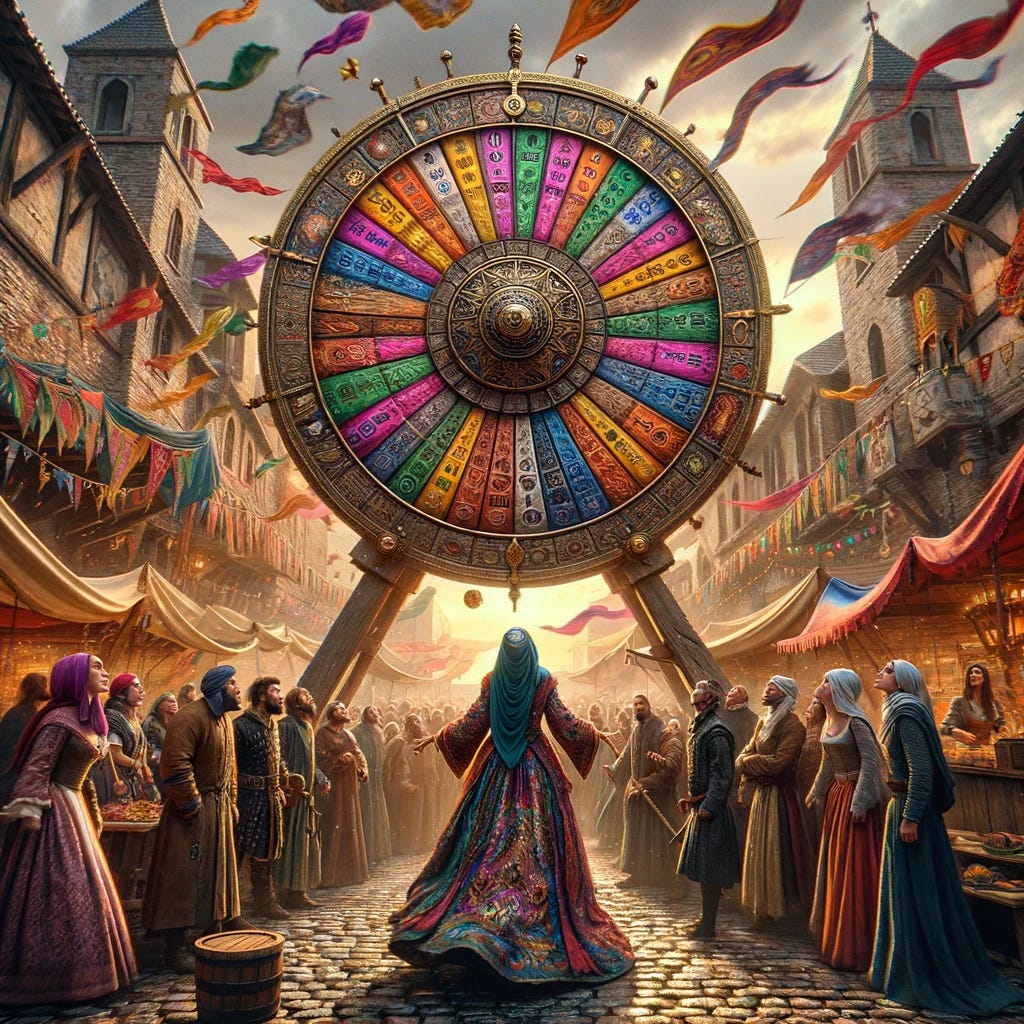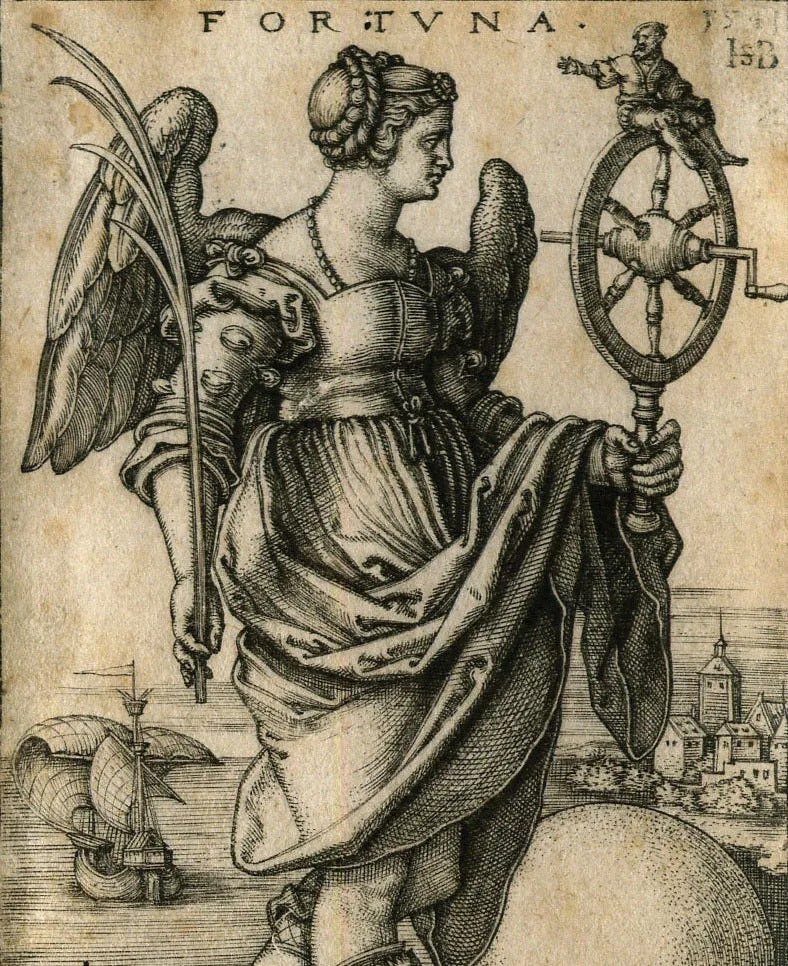Wheel of Fortune is Way More Interesting Than You Think
You're Welcome. The Deep End #14
Let’s play Wheel of Fortune!
Everyone knows the game. It’s been around since the 1970s and has been a mainstay in the American lexicon since the evening program starring Pat Sajak and Vanna White first aired in 1983.
You know the rules: spin the wheel, guess the letters, and win prizes. Wheel of Fortune was invented by Merv Griffin, who you also know as the creator of Jeopardy!. The game (Wheel of Fortune) is based on the even more classic game, Hangman—which may be based on an even older game called Birds, Beasts, and Fishes. The game is pretty simple. You guess letters that fill out a phrase. If you get the letters (and eventually the phrase) correct, you win.
It’s ingenious! And it has captivated viewers for decades. Wheel of Fortune is one of those things that you can’t even remember not existing. After all, the game show has been around since its inception without much change. It’s been the same wheel, studio, and hosts since the beginning. Pat and Vanna are just a tad bit older than they were when they started working on the thing (although Ryan Seacrest is set to take over for Sajak in September of this year, ending his splendid run that lasted over forty years).
What I’m saying is: you can’t fault yourself for feeling like Wheel of Fortune has been around forever. In fact, it actually has been around forever. I’ll explain.
Let me introduce you to Fortuna. She’s better known as the Roman goddess of fortune, luck, and fate. Her Greek counterpart is Tyche. Daughter of the god Jupiter (Zeus), Fortuna was conceived—let me stop. No one cares about the historical (and gross) familial banging that went on in the ancient Roman and Greek heavens above.
Fortuna was the goddess of luck, as I just mentioned. Depictions of her are famous for showing the drip she usually hauls around with her. She’s typically seen carrying a gubernaculum (whatever the hell that means), a cornucopia, and a wheel.
Did you catch the thing I mentioned last? Yep, a wheel. Fortuna carries around a wheel.
Now. Allow me to introduce to you: Rota Fortunae, or the Wheel of Fortune. The Rota Fortunae is an ancient symbol of fate. The Wheel of Fortune was the metaphor’s medieval counterpart.
As the name goes, the Rota belonged to Fortuna. In the depictions of the Rota Fortunae, Fortuna is blindfolded. She spins the Rota blindly, which illustrates the random chances of fortune and misfortune that people are met with over the course of their lives. No matter how unfair it might seem, some of us could strike gold at the drop of a hat, while others who deserve better are left with nothing due to their unlucky lot in life.
Rota Fortunae was popularized in the Middle Ages as the Wheel of Fortune after the release of The Consolation of Philosophy, by Boethius, a senator and philosopher who lived in Rome from the 5th-6th century. (Can I just mention his full name is Anicius Manlius Severinus Boethius. Manlius!? That’s pretty cool. Also, he’s actually recognized as a saint by the Catholic church—even though he wasn’t a priest or anything of the sort.)
The Consolation of Philosophy was written in 523 AD while Boethius was imprisoned and awaiting execution for treason against the Ostrogoth King. In case you didn’t know—and trust me, I didn’t, either—the Ostrogoths ruled Italy before the Lombards turned it into a kingdom in 563.
The Consolation of Philosophy is written as a conversation between Boethius and “Lady Philosophy.” The book discusses such topics as happiness, suffering, and evil’s existence in a world ruled by God. The Wheel of Fortune is discussed in the second “book” in the book. Here, the author and Lady Philosophy talk about living in a world where good or bad luck may strike you without a moment’s notice. They claim happiness can still be had—by pursuing wisdom! If being named Manlius didn’t already sell me on this guy…
So, what’s my point here? I think it actually might be that Boethius is a complete and total badass! I mean seriously, his life sounds really cool, even with the whole being executed on orders of the goth king at the age of 44.
The goth king pictured here.
The Consolation of Philosophy was heavily inspired by Plato’s dialogues and stoic philosophy, and is said to be the last great work of the classical period. The book is also considered one of the greatest works to ever be written in prison, so there’s that.
Some of Boethius’s career achievements include reaching the status of senator by age 25, becoming consul by 33, and being chosen as personal advisor to the king that would ultimately sentence him to death. Sweet. Oh yeah, and he’s a saint. Somehow, he is considered to have died a martyr of the Catholic faith. Resources explaining why a Roman senator and philosopher’s politically-motivated death would grant him sainthood have been hard for me to find…
Anyway. My boy is still heralded as one of the all-time greatest thinkers. He’s been called “the last of the Roman philosophers” by Edward Kennard Rand (whoever that is). And he’s been mentioned in famous books like Dante’s Divine Comedy and John Kennedy Toole’s A Confederacy of Dunces.
Here’s another reference to Boethius you may have heard (this one being unrelated to the hit game show Wheel of Fortune). It’s the concept that history is a circle. “The Boethian Wheel” is his concept that history is like a wheel, always repeating itself.
As the wheel spins, some will rise from the bottom, while others fall off as it comes around on the other side. Wars will come and go. Kingdoms will conquer and die out. Men may go from starving to powerful. But in the end, we all end up dead in the soil with a new group of people taking our place and repeating the same mistakes we did.
I ♡ Boethius shirts available now.
Seriously, though, if you love Boethius, the goth king, and/or Thinking Man, check out our merch store, linked below. Happy shopping (I mean… Sunday)!







More info on Boethius not hard to find.....
https://www.catholic.com/encyclopedia/Anicius-Manlius-Severinus-Boethius